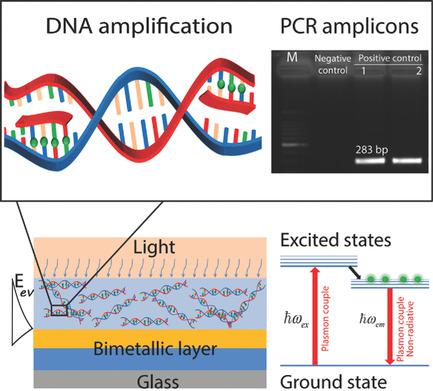Our official English website, www.x-mol.net, welcomes your
feedback! (Note: you will need to create a separate account there.)
Reproducible Enhancement of Fluorescence by Bimetal Mediated Surface Plasmon Coupled Emission for Highly Sensitive Quantitative Diagnosis of Double‐Stranded DNA
Small ( IF 13.0 ) Pub Date : 2018-07-12 , DOI: 10.1002/smll.201801385 Nhu Hoa Thi Tran 1, 2 , Kieu The Loan Trinh 3 , Jun-Ho Lee 1, 4 , Won Jung Yoon 5 , Heongkyu Ju 1, 2, 6
Small ( IF 13.0 ) Pub Date : 2018-07-12 , DOI: 10.1002/smll.201801385 Nhu Hoa Thi Tran 1, 2 , Kieu The Loan Trinh 3 , Jun-Ho Lee 1, 4 , Won Jung Yoon 5 , Heongkyu Ju 1, 2, 6
Affiliation

|
Plasmonic enhancement of fluorescence from SYBR Green I conjugated with a double‐stranded DNA (dsDNA) amplicon is demonstrated on polymerase chain reaction (PCR) products. Theoretical computation leads to use of the bimetallic (Au 2 nm–Ag 50 nm) surface plasmons due to larger local fields (higher quality factors) than monometallic (Ag or Au) ones at both dye excitation and emission wavelengths simultaneously, optimizing fluorescence enhancement with surface plasmon coupled emission (SPCE). Two kinds of reverse Kretschmann configurations are used, which favor, in signal‐to‐noise ratio, a fluorescence assay that uses optically dense buffer such as blood plasma. The fluorescence enhancement (12.9 fold at maximum) with remarkably high reproducibility (coefficient of variation (CV) < 1%) is experimentally demonstrated. This facilitates credible quantitation of enhanced fluorescence, however unlikely to obtain by localized surface plasmons. The plasmon‐induced optical gain of 46 dB due to SPCE‐active dye molecules is also estimated. The fluorescence enhancement technologies with PCR enables LOD of the dsDNA template concentration of ≈400 fg µL−1 (CV < 1%), the lowest ever reported in DNA fluorescence assay to date. SPCE also reduces photobleaching significantly. These technologies can be extended for a highly reproducible and sufficiently sensitive fluorescence assay with small volumes of analytes in multiplexed diagnostics.
中文翻译:

双金属介导的表面等离激元耦合发射对荧光的可再现增强,可用于双链DNA的高灵敏度定量诊断。
在聚合酶链反应(PCR)产品上证实了等离子增强了SYBR Green I与双链DNA(dsDNA)扩增子偶联的荧光。理论计算导致使用双金属(Au 2 nm–Ag 50 nm)表面等离激元,这是因为在染料激发和发射波长同时,比单金属(Ag或Au)更大的局部场(更高的品质因数),优化了荧光增强。表面等离激元耦合发射(SPCE)。使用两种反向Kretschmann配置,它们在信噪比方面有利于使用光密缓冲液(例如血浆)的荧光测定。实验证明了荧光增强(最大12.9倍)的重现性(变异系数(CV)<1%)。这有助于对增强的荧光进行可靠的定量,但是不可能通过局部表面等离子体激元获得。还估计了由于SPCE活性染料分子引起的等离激元诱导的光学增益为46 dB。PCR荧光增强技术使dsDNA模板浓度的LOD达到约400 fg µL-1(CV <1%),是迄今为止在DNA荧光测定法中报告的最低值。SPCE还可以显着减少光漂白。这些技术可以扩展为高度可重现的和足够灵敏的荧光分析方法,并在多重诊断中使用少量分析物。
更新日期:2018-07-12
中文翻译:

双金属介导的表面等离激元耦合发射对荧光的可再现增强,可用于双链DNA的高灵敏度定量诊断。
在聚合酶链反应(PCR)产品上证实了等离子增强了SYBR Green I与双链DNA(dsDNA)扩增子偶联的荧光。理论计算导致使用双金属(Au 2 nm–Ag 50 nm)表面等离激元,这是因为在染料激发和发射波长同时,比单金属(Ag或Au)更大的局部场(更高的品质因数),优化了荧光增强。表面等离激元耦合发射(SPCE)。使用两种反向Kretschmann配置,它们在信噪比方面有利于使用光密缓冲液(例如血浆)的荧光测定。实验证明了荧光增强(最大12.9倍)的重现性(变异系数(CV)<1%)。这有助于对增强的荧光进行可靠的定量,但是不可能通过局部表面等离子体激元获得。还估计了由于SPCE活性染料分子引起的等离激元诱导的光学增益为46 dB。PCR荧光增强技术使dsDNA模板浓度的LOD达到约400 fg µL-1(CV <1%),是迄今为止在DNA荧光测定法中报告的最低值。SPCE还可以显着减少光漂白。这些技术可以扩展为高度可重现的和足够灵敏的荧光分析方法,并在多重诊断中使用少量分析物。











































 京公网安备 11010802027423号
京公网安备 11010802027423号